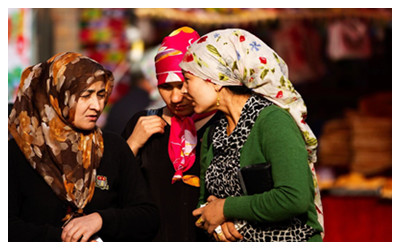Uygur Costoms
 The Uygurs' cotton growing and cotton yarn spinning industry has a long history. Working people usually wear cotton cloth garments. Men sport a long gown called a qiapan, which opens on the right and has a slanted collar. It is buttonless and is bound by a long square cloth band around the waist. Women wear broad-sleeved dresses and black waist coats with buttons sewn on the front. Some now like to wear Western-style suits and skirts. The Uygurs, old and young, men and women, like to wear a small cap with four pointed corners, embroidered with black and white or colored silk threads in traditional Uygur designs. The women's favourite decorations include earrings, bracelets and necklaces. Some paint their eyebrows and fingernails on grand festive occasions. Girls in the past combed their hair into a dozen pigtails, and regarded long hair as part of female beauty. After marriage, they usually wear two pigtails with loose ends, decorated on the head with a crescentshaped comb. Some tuck up their pigtails into a bun.
The Uygurs' cotton growing and cotton yarn spinning industry has a long history. Working people usually wear cotton cloth garments. Men sport a long gown called a qiapan, which opens on the right and has a slanted collar. It is buttonless and is bound by a long square cloth band around the waist. Women wear broad-sleeved dresses and black waist coats with buttons sewn on the front. Some now like to wear Western-style suits and skirts. The Uygurs, old and young, men and women, like to wear a small cap with four pointed corners, embroidered with black and white or colored silk threads in traditional Uygur designs. The women's favourite decorations include earrings, bracelets and necklaces. Some paint their eyebrows and fingernails on grand festive occasions. Girls in the past combed their hair into a dozen pigtails, and regarded long hair as part of female beauty. After marriage, they usually wear two pigtails with loose ends, decorated on the head with a crescentshaped comb. Some tuck up their pigtails into a bun.
Over the centuries, many mosques, mazas (Uygur complexes, nobles' tombs), theological seminaries and religious courts were set up in Uygur areas. Over the past few hundred years, religion has greatly influenced economic, judicial and educational affairs and the Uygur family and matrimonial system. Some of the rich people made use of religious rules to marry more than one wife, and had the right to divorce them at any time. The marriage of the ordinary Uygurs was mostly arranged by the parents. Male chauvinism was practiced in the family, and Uygur women, humiliated and with nobody to turn to, often retreated into prayer.
After 1949, feudal religious privileges were abolished, and religion was taken out of the control of the reactionary ruling class, and became a matter of individual conscience. As science and knowledge spread, many of the old feudalistic religious habits lost popularity. People can now decide for themselves whether the Sawm should be observed during Ramadan, how many naimazi (services) should be performed in a day and whether women in the street should wear veils.
As these matters do not affect normal religious belief, the Uygurs are beginning to enjoy a more genuine religious freedom. The family, marriage and property are under the protection of the law, and Uygur women enjoy equality with men. Many are now working alongside men in modern industries.
There are now more than a dozen million Moslems in the country, compared with eight million in the early post-1949 period. In 1953, the Chinese Islamic Association was established with Burhan Shahidi as its chairman. More than seven million people in Xinjiang believe in Islam, accounting for well over half of the national total. In the mid-1080s, there were 15,800 religious professionals, about 2,000 of whom were either deputies to the People's Congress or the Chinese People's Political Consultative Conference at various levels, or worked in the regional or county branches of the Chinese Islamic Association. The region now boasts a total of 15,500 mosques or prayer centers, or one for almost every Moslem village.

 Ask Questions ?
Ask Questions ?